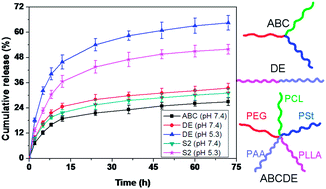a Jiangsu Key Laboratory of Advanced Functional Polymer Design and Application, Department of Polymer Science and Engineering, College of Chemistry, Chemical Engineering and Materials Science, Soochow University, Suzhou 215123, China
Polym. Chem. 2014, 5, 3071-3080
The synthesis and properties of a star quintopolymer comprising poly(ethylene glycol) (PEG, A), poly(ε-caprolactone) (PCL, B), polystyrene (PSt, C), poly(L-lactide) (PLLA, D), and poly(acrylic acid) (PAA, E) segments were described. Terminal diazide functionalized PEG (PEG-(N3)2), alkyne-mid-functionalized PCL-b-PSt and PLLA-b-PtBA diblock copolymers acted as building blocks to synthesize the target ABCDE star via modular synthesis. DSC analyses revealed that star copolymers usually exhibited complex chain relaxation and melting behaviors although arm segments were partly compatible. Various copolymers could self-assemble into vesicles (for ABC and ABCDE stars) and micelles (for the DE copolymer) in aqueous solution, and the release rate of doxorubicin from various aggregates at pH 7.4 decreased in the order DE > ABCDE star > ABC star. For the same types of aggregates, the increment in the cumulative amount at pH 5.3 for 72 h was 66.9% (for ABCDE vesicles) and 92.5% (for DE micelles), higher than that at pH 7.4 in the same period, revealing the remarkably accelerated release kinetics under acidic conditions. The ABCDE vesicles had great potential as controlled delivery vehicles due to their excellent stability, satisfactory drug loading efficiency, and pH-responsive drug release properties.

链接:
//pubs.rsc.org/en/content/articlelanding/2014/py/c3py01601c#!divAbstract